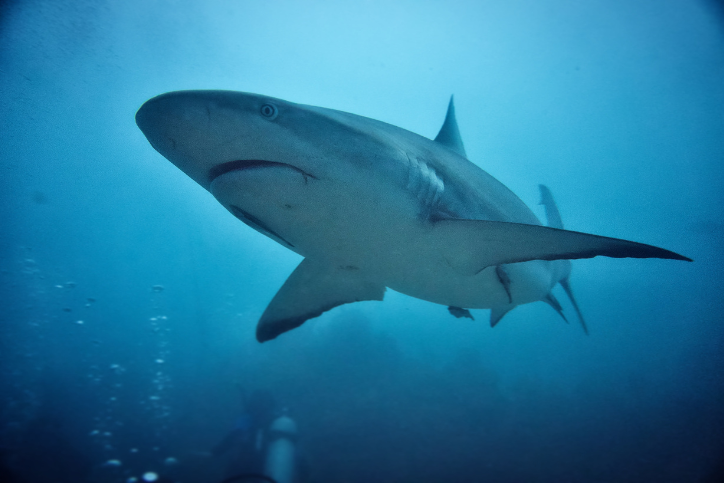Sharks have been living in almost all oceans for over 25 million years. They can be found near the coast, the high sea as well as the deep sea, on the seabed or in estuaries.
They belong to the cartilaginous fish and are divided into 3 species: rays, sharks, sea cats.
There are about 500 species of sharks and they reach sizes from 20 cm to 14 m.
The well-known prehistoric shark Megalodon was up to 20 meters long. The whale shark is the largest currently living shark in the world’s oceans. It grows up to 14 meters but is a pure plankton eater.
How old do sharks get?
On average, they reach an age of several decades. The great white shark can live about 70 years. The Greenland sharks live the longest. They live up to 400 years. They reach this age due to their slow metabolism and the cold waters in which they live. However, Greenland sharks do not reach puberty until they are 150 years old!
The shark – a special creature
The sharkskin is very special and can only be found with them! Their toothed skin surface is one of the prime examples of bionics. The so-called “placoid scales” cover the entire shark body and are structurally structured like teeth, so-called skin-teeth. If you stroke the shark from the head to the caudal fin, the skin feels smooth. Against the direction of growth, the skin is rough and resembles sand or sandpaper. Since the scales are directed backwards, there is hardly any flow resistance, which allows rapid locomotion. The skin is also very resistant and offers protection against parasites and injuries. Bionics makes use of this “riblet effect” in livery techniques for aircrafts or boats.
Sharks have a so-called revolver bite, so they have several rows of teeth. Every time a tooth breaks out, a new one moves in. This allows them to consume around 30,000 teeth in the shark’s life.
Their sense of smell is also very pronounced. They can prey in a concentration of 1:10 billion. Because their olfactory center alone accounts for 2/3 of the brain mass.
Since they are nocturnal, their eyes are also adapted to the conditions. Behind the eyes are reflectors made of tiny crystals that amplify the incident light. Because their eyes sit sideways, they can see in all directions. In the event of attacks, the nick skin offers them protection, which works like an eyelid.
Their liver makes up to one quarter of their body weight and consists of 90% pure fat. This provides buoyancy as they do not have a swim bladder like other fish, and it reduces their weight in the water.
But they also have a 6th sense by means of the Lorenzinian ampoules. That’s hundreds of pores under the skin that stretch from the head to the tail area. They can thus perceive electric fields, such as the heartbeat of animals buried in the sand and temperature differences. They thus interact with the Earth’s magnetic field, which is also important for mating.
Sharks only become sexually mature with about 30 years and only get progenies every 2 years due to the long gestation period. Therefore, their stock cannot be restored so quickly. Some species are oviparous others are viviparous.
Baby sharks grow up in shallow coastal areas or mangrove forests to protect themselves from predators.
The fear of the shark
There are up to 100 shark attacks every year, with unfortunately 5 to a maximum of 10 fatal. Did you know that in contrast, around 25,000 people die each year from dog bites? But sharks have never eaten a living human. Since they are very curious animals and hardly see in poor visibility (e.g. It usually hits surfers who stay in areas where the waves break and the sand clouds the view), they only make a test bite to determine whether the human is a potential prey. Because we are not on their menu, they let go right away. The secondary injuries caused by tearing off end fatally for humans or they bleed to death in the water, as help takes longer to come.
Danger to sharks
Adult sharks have hardly any natural predators. The biggest danger here is mankind. 100 million sharks are killed by “Shark Finning” every year. This means that the fins of the captured shark are cut off alive and then thrown back into the sea, where it drowns, bleeds to death or is eaten by other sharks. The consumption of shark fins is particularly popular in Asia and therefore makes them very expensive. Their meat itself is worth nothing. Since they are at the top of the food chain in the sea and they feed on other fish, their meat often becomes inedible due to heavy metals and other toxic substances.
By the way, did you know that Spain is the biggest shark fishing nation in Europe? Shark is also eaten in Germany, “Schillerlocken” are made from the meat of the dogfish.
Another problem for sharks is bycatch in fisheries. Through miles of trawl nets, all sorts of marine life get caught in these nets, whether dolphins, turtles or sharks. Bycatch accounts for up to 90% of the fish caught in fisheries.
Therefore, many shark species are already threatened with extinction: more than 70 are already on the red list.
But overfishing is also increasingly exacerbating the dwindling population of sharks. They are at the top of the food chain. If you deprive them of food in their natural habitat, there will soon be no more life in the oceans.
Because it preserves the ecological balance of the oceans.
Projects for the protection of sharks
There are now several projects for the protection of sharks.
Sharkproject is an international shark and species conservation organization that promotes intact shark populations worldwide through protection, training, and cooperation.
I would also like to mention the Save the Med Foundation in Mallorca.
Their mission: to support the Mediterranean to restore its rich biodiversity and thrive in harmony with an environmentally conscious and proactive local population. The aim is to help the Balearic shark population to recover. The government, the population as well as the fisheries sector are involved in the implementation of the project.
Dear readers, I would like to make you aware about: If the shark dies – mankind also dies!

